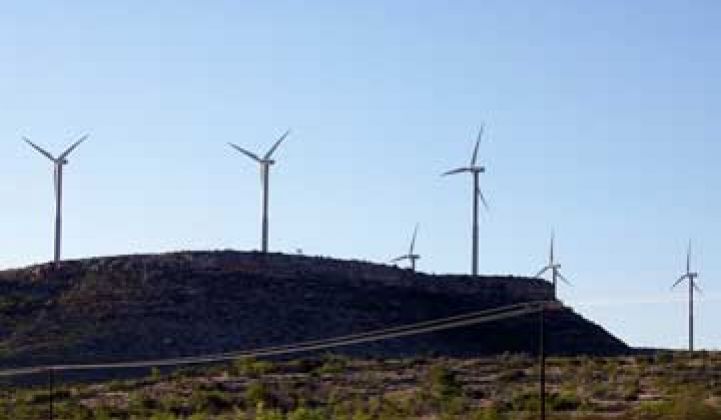At a recent conference, Networked Solar, which looked at the intersection of solar and smart grid, a lot of panelists threw around the idea that demand response would be one of many solutions that could be used to bring large amounts of solar, or any other renewable energy, on to the aging electrical grid.
What a fine idea! It all sounds so beautiful in theory: wind and solar replace dirtier forms of electricity and are supported by a well-oiled system where certain loads are increased or decreased to help mitigate the intermittency of renewables.
However, as with everything related to smart grid, the reality is far murkier. Demand response is already being used as an ancillary service in some markets, providing backup services when there’s a drop in production because the wind dies down, a transmission line snaps, or any other issue that may plague the grid occurs. But DR has not yet reached its full potential due to regulatory concerns, payment structures and response time limitations. There is no doubt that independent system operators see the growth of DR as one way to deal with high penetration of renewables, but how that solution will be realized is still an open question.
“No one really knows exactly how it will work,” said Gregg Dixon, Senior VP of Marketing at EnerNOC. “What we do know is that we will absolutely need it.”
Currently, DR is being used as a spinning reserve in certain ISOs, including ERCOT and PJM Interconnection, where loads are given a 10-minute heads-up before they have to drop off. In the case of PJM, the most that DR has ever contributed to the spinning reserves is about 16 percent, according to Susan Covino, Manager of Demand Side Response. She reports that PJM can now only use DR for up to 25 percent of spinning resources, but after years of successful deployment, PJM is prepared to lift that ceiling to 35 percent.
Down in Texas, half of ERCOT’s “responsive reserves” (apparently, no one can agree on the nomenclature for spinning reserves) can be provided by DR, a figure equal to 1,150 megawatts, and usually it gets more offers than it needs on any given day.
That’s the simple part. To really benefit the integration of renewables, DR needs to provide a whole lot more than shutting down megawatts with a 10-minute head start. In the future, DR will need to be dispatched within seconds. Currently, the technology isn’t in place to do that -- and neither is the platform for how DR providers would get paid.
“To get to an economic dispatch of DR [for non-spin and regulation services] -- that’s the goal out there,” said Paul Wattles, Supervisor of Demand Response for ERCOT, “and it’s not ready for primetime yet.”
ERCOT’s real-time energy dispatching service can’t even handle offers from demand response providers. In order for that to happen, DR would have to fully automated, rather than relying on messages to building operators to manually turn down systems. Some of that is already happening with the OpenADR standard, which is being adopted across California and also by major players like EnerNOC. Akuacom, a company that uses OpenADR standards and was acquired by Honeywell last year, is working on building on the OpenADR platform so that it can receive the automatic generation control signal that generators are set up to respond to.
But figuring out real-time dispatch still only solves one problem. If load dispatch can find a way to regulate frequency -- “Well, isn’t that the Holy Grail?” asked John Goodin, DR lead for the California ISO. Although CalISO isn’t even allowed to use DR as a spinning reserve by the Western Electricity Coordinating Council (though that will change in the next year or two), it’s already looking forward to how it can be used as a regulation source. Lawrence Berkley National Laboratory is studying the types of customers that could provide regulation through DR services, such as thermal energy storage, wastewater with pondage or even lighting in commercial buildings. PJM has “high hopes” that DR could enter the regulation market as soon as this year.
The large ISOs are not the only regions setting up projects to work out the kinks on the future of DR for the grid. At Bonneville Power Administration, EnerNOC will use its demand response capacity to balance out the ramping up and down of its wind resources. “DR has been thought of being able to curtail power, but you actually need a power stump -- when wind/solar overproduce, you ideally need something to relieve the pressure,” said EnerNOC. At BPA, they will be looking at a cold storage facility to absorb extra power when necessary.
Although the focus is currently on ways that industrial and commercial customers can provide demand response 3.0 for renewables, both Wattles at ERCOT and Goodin at CalISO also mentioned that the next stage of DR is not just about its role in renewables.
“I see that there are two flavors [of DR]: there’s the high-quality, for how much, when I need it, where I need it [variety],” said Goodin. “Then, there’s the price responsive [variety].”
Dynamic pricing and demand response for untapped markets can’t help ISOs with renewables, but both said there’s still space for huge gains if automated DR can be married with the right price signals. “I think when you start doing [DR] for residential and small commercial, that’s when you see the potential,” said Wattles. “In a lot of cases, it’s a cheaper way to get there.”



